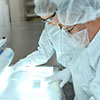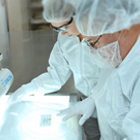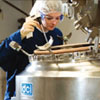cell+culture+flasks
Numéro de catalogue:
(BOSSBS-7032R-A680)
Fournisseur:
Bioss
Description:
Receptor tyrosine kinase which binds promiscuously membrane-bound ephrin family ligands residing on adjacent cells, leading to contact-dependent bidirectional signaling into neighboring cells. The signaling pathway downstream of the receptor is referred to as forward signaling while the signaling pathway downstream of the ephrin ligand is referred to as reverse signaling. Highly promiscuous for ephrin-A ligands it binds preferentially EFNA5. Upon activation by EFNA5 regulates cell-cell adhesion, cytoskeletal organisation and cell migration. Plays a role in cardiac cells migration and differentiation and regulates the formation of the atrioventricular canal and septum during development probably through activation by EFNA1. Involved in the retinotectal mapping of neurons. May also control the segregation but not the guidance of motor and sensory axons during neuromuscular circuit development.
UOM:
1 * 100 µl
Numéro de catalogue:
(BOSSBS-6076R-CY3)
Fournisseur:
Bioss
Description:
Cooperates with AGTR2 to inhibit ERK2 activation and cell proliferation. May be required for AGTR2 cell surface expression. Together with PTPN6, induces UBE2V2 expression upon angiotensin-II stimulation. Isoform 1 inhibits breast cancer cell proliferation, delays the progression of mitosis by prolonging metaphase and reduces tumor growth.
UOM:
1 * 100 µl
Numéro de catalogue:
(BOSSBS-2521R)
Fournisseur:
Bioss
Description:
Plays a role as a receptor for the recognition of MHC class I HLA-E molecules by NK cells and some cytotoxic T-cells.
UOM:
1 * 100 µl
Numéro de catalogue:
(BOSSBS-5203R-FITC)
Fournisseur:
Bioss
Description:
Autophagy is the process by which endogenous proteins and damaged organelles are destroyed intracellularly. Autophagy is postulated to be essential for cell homeostasis and cell remodeling during differentiation, metamorphosis, non-apoptotic cell death, and aging. Reduced levels of autophagy have been described in some malignant tumors, and a role for autophagy in controlling the unregulated cell growth linked to cancer has been proposed. This gene encodes a member of the autophagin protein family. The encoded protein is also designated as a member of the C-54 family of cysteine proteases. [provided by RefSeq].
UOM:
1 * 100 µl
Numéro de catalogue:
(BOSSBS-5203R-CY5)
Fournisseur:
Bioss
Description:
Autophagy is the process by which endogenous proteins and damaged organelles are destroyed intracellularly. Autophagy is postulated to be essential for cell homeostasis and cell remodeling during differentiation, metamorphosis, non-apoptotic cell death, and aging. Reduced levels of autophagy have been described in some malignant tumors, and a role for autophagy in controlling the unregulated cell growth linked to cancer has been proposed. This gene encodes a member of the autophagin protein family. The encoded protein is also designated as a member of the C-54 family of cysteine proteases. [provided by RefSeq].
UOM:
1 * 100 µl
Numéro de catalogue:
(BOSSBS-5203R-CY5.5)
Fournisseur:
Bioss
Description:
Autophagy is the process by which endogenous proteins and damaged organelles are destroyed intracellularly. Autophagy is postulated to be essential for cell homeostasis and cell remodeling during differentiation, metamorphosis, non-apoptotic cell death, and aging. Reduced levels of autophagy have been described in some malignant tumors, and a role for autophagy in controlling the unregulated cell growth linked to cancer has been proposed. This gene encodes a member of the autophagin protein family. The encoded protein is also designated as a member of the C-54 family of cysteine proteases. [provided by RefSeq].
UOM:
1 * 100 µl
Numéro de catalogue:
(BOSSBS-13626R-A647)
Fournisseur:
Bioss
Description:
Several proteins involved in regulating and executing programmed cell death have been identified in C. elegans. CED-3, a member of the ICE protease/caspase family, and CED-4, a homolog of the mammalian Apaf-1, promote apoptosis. CED-9, a homolog of the mammalian Bcl-2 protein, inhibits cell death. EGL-1 and CED-6 both function as death-promoting proteins, with CED-6 playing a role in the engulfment of apoptotic cells. CED-5 and CED-7 are C. elegans orthologs of the mammalian DOCK180 and ABC transporter proteins, respectively, and also play a role in the engulfment of dying cells.
UOM:
1 * 100 µl
Numéro de catalogue:
(BOSSBS-13626R-CY7)
Fournisseur:
Bioss
Description:
Several proteins involved in regulating and executing programmed cell death have been identified in C. elegans. CED-3, a member of the ICE protease/caspase family, and CED-4, a homolog of the mammalian Apaf-1, promote apoptosis. CED-9, a homolog of the mammalian Bcl-2 protein, inhibits cell death. EGL-1 and CED-6 both function as death-promoting proteins, with CED-6 playing a role in the engulfment of apoptotic cells. CED-5 and CED-7 are C. elegans orthologs of the mammalian DOCK180 and ABC transporter proteins, respectively, and also play a role in the engulfment of dying cells.
UOM:
1 * 100 µl
Numéro de catalogue:
(BOSSBS-3680R-A350)
Fournisseur:
Bioss
Description:
Tumor suppressor. Promotes rapid degradation of CTNNB1 and participates in Wnt signaling as a negative regulator. APC activity is correlated with its phosphorylation state. Activates the GEF activity of SPATA13 and ARHGEF4. Plays a role in hepatocyte growth factor (HGF)-induced cell migration. Required for MMP9 up-regulation via the JNK signaling pathway in colorectal tumor cells. Acts as a mediator of ERBB2-dependent stabilization of microtubules at the cell cortex. It is required for the localization of MACF1 to the cell membrane and this localization of MACF1 is critical for its function in microtubule stabilization.
UOM:
1 * 100 µl
Numéro de catalogue:
(BOSSBS-3680R-A555)
Fournisseur:
Bioss
Description:
Tumor suppressor. Promotes rapid degradation of CTNNB1 and participates in Wnt signaling as a negative regulator. APC activity is correlated with its phosphorylation state. Activates the GEF activity of SPATA13 and ARHGEF4. Plays a role in hepatocyte growth factor (HGF)-induced cell migration. Required for MMP9 up-regulation via the JNK signaling pathway in colorectal tumor cells. Acts as a mediator of ERBB2-dependent stabilization of microtubules at the cell cortex. It is required for the localization of MACF1 to the cell membrane and this localization of MACF1 is critical for its function in microtubule stabilization.
UOM:
1 * 100 µl
Numéro de catalogue:
(BOSSBS-3680R-CY7)
Fournisseur:
Bioss
Description:
Tumor suppressor. Promotes rapid degradation of CTNNB1 and participates in Wnt signaling as a negative regulator. APC activity is correlated with its phosphorylation state. Activates the GEF activity of SPATA13 and ARHGEF4. Plays a role in hepatocyte growth factor (HGF)-induced cell migration. Required for MMP9 up-regulation via the JNK signaling pathway in colorectal tumor cells. Acts as a mediator of ERBB2-dependent stabilization of microtubules at the cell cortex. It is required for the localization of MACF1 to the cell membrane and this localization of MACF1 is critical for its function in microtubule stabilization.
UOM:
1 * 100 µl
Numéro de catalogue:
(BOSSBS-3680R-CY5.5)
Fournisseur:
Bioss
Description:
Tumor suppressor. Promotes rapid degradation of CTNNB1 and participates in Wnt signaling as a negative regulator. APC activity is correlated with its phosphorylation state. Activates the GEF activity of SPATA13 and ARHGEF4. Plays a role in hepatocyte growth factor (HGF)-induced cell migration. Required for MMP9 up-regulation via the JNK signaling pathway in colorectal tumor cells. Acts as a mediator of ERBB2-dependent stabilization of microtubules at the cell cortex. It is required for the localization of MACF1 to the cell membrane and this localization of MACF1 is critical for its function in microtubule stabilization.
UOM:
1 * 100 µl
Numéro de catalogue:
(BOSSBS-0080R-A350)
Fournisseur:
Bioss
Description:
B lymphocytes marker CD20 is a non glycosylated protein with a molecular weight of 35 or 37 kDa depending on the degree of phosphorylation. Although not a member of the tetraspanin superfamily of cell surface receptors, it crosses the cell membrane four times. The CD20 antigen is present on human pre B lymphocytes and on B lymphocytes at all stages of maturation, except on plasma cells. Low level expression of the CD20 antigen has been detected on normal T lymphocytes. The CD20 molecule is involved in regulation of B cell differentiation, presumably via its reported function as a Ca++ channel subunit.
UOM:
1 * 100 µl
Numéro de catalogue:
(BOSSBS-0080R-A647)
Fournisseur:
Bioss
Description:
B lymphocytes marker CD20 is a non glycosylated protein with a molecular weight of 35 or 37 kDa depending on the degree of phosphorylation. Although not a member of the tetraspanin superfamily of cell surface receptors, it crosses the cell membrane four times. The CD20 antigen is present on human pre B lymphocytes and on B lymphocytes at all stages of maturation, except on plasma cells. Low level expression of the CD20 antigen has been detected on normal T lymphocytes. The CD20 molecule is involved in regulation of B cell differentiation, presumably via its reported function as a Ca++ channel subunit.
UOM:
1 * 100 µl
Numéro de catalogue:
(BOSSBS-12481R-A647)
Fournisseur:
Bioss
Description:
Tumor suppressor. Promotes rapid degradation of CTNNB1 and participates in Wnt signaling as a negative regulator. APC activity is correlated with its phosphorylation state. Activates the GEF activity of SPATA13 and ARHGEF4. Plays a role in hepatocyte growth factor (HGF)-induced cell migration. Required for MMP9 up-regulation via the JNK signaling pathway in colorectal tumor cells. Acts as a mediator of ERBB2-dependent stabilization of microtubules at the cell cortex. It is required for the localization of MACF1 to the cell membrane and this localization of MACF1 is critical for its function in microtubule stabilization.
UOM:
1 * 100 µl
Fournisseur:
Tonbo Biosciences
Description:
The RA3-6B2 antibody reacts with the human and mouse CD45 isoform known as CD45R, or B220, a protein tyrosine phosphatase of 220 kDa. CD45 is one of the most abundant hematopoietic markers, and is expressed on all leukocytes (the Leukocyte Common Antigen, LCA). Various isoforms are generated and expressed in cell-specific patterns, all critical for leukocyte function. In mouse, the CD45R/B220 isoform is predominantly found on B cells, at varying levels on all stages from pro-B cells to activated B cells, and may also be detected on certain T cell and NK cell subsets. It is of note that B220 is not similarly expressed on human B cells, where it appears to be differentiation-specific and therefore expressed on only some B cell subsets. Other forms of CD45 with restricted cellular expression include CD45RA, CD45RB, CD45RO and several others. The RA3-6B2 antibody is one of the most consistently used leukocyte markers for B cells, T cell subsets and NK cell subsets in human and mouse. This antibody has also been reported as cross-reactive with feline CD45R/B220.
Appel de prix
Le stock de cet article est limité mais peut être disponible dans un entrepôt proche de vous. Merci de vous assurer que vous êtes connecté sur le site afin que le stock disponible soit affiché. Si l'
Le stock de cet article est limité mais peut être disponible dans un entrepôt proche de vous. Merci de vous assurer que vous êtes connecté sur le site afin que le stock disponible soit affiché. Si l'
Ces articles ne peuvent être ajoutés au Panier. Veuillez contacter votre service client ou envoyer un e-mail à vwr.be@vwr.com
Une documentation supplémentaire peut être nécessaire pour l'achat de cet article. Un représentant de VWR vous contactera si nécessaire.
Ce produit a été bloqué par votre organisation. Contacter votre service d'achat pour plus d'informations.
Le produit original n'est plus disponible. Le remplacement représenté est disponible
Les produits marqués de ce symbole ne seront bientôt plus disponibles - vente jusqu'à épuisement de stock. Des alternatives peuvent être disponibles en recherchant le code article VWR indiqué ci-dessus. Si vous avez besoin d'une assistance supplémentaire, veuillez contacter notre Service Clientèle au 016 385 011.
|
|||||||||
















































